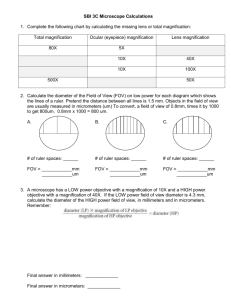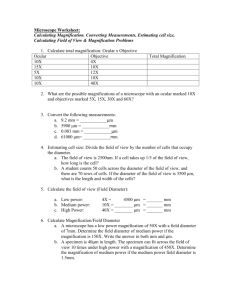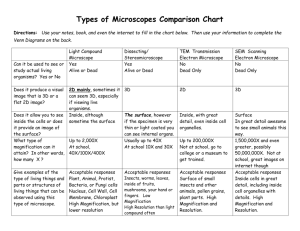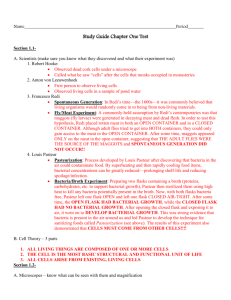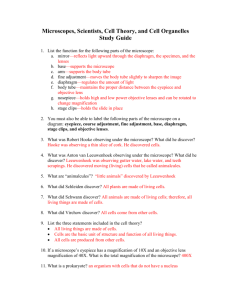Intro to Microscope Lab Guidelines
advertisement
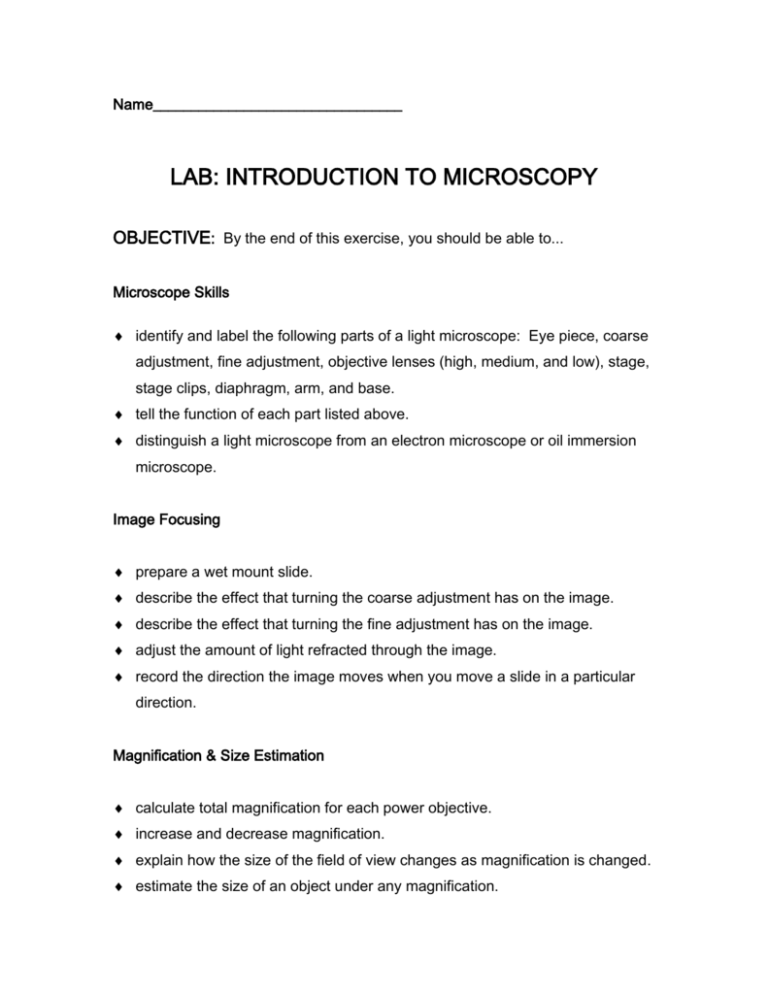
Name_________________________________ LAB: INTRODUCTION TO MICROSCOPY OBJECTIVE: By the end of this exercise, you should be able to... Microscope Skills identify and label the following parts of a light microscope: Eye piece, coarse adjustment, fine adjustment, objective lenses (high, medium, and low), stage, stage clips, diaphragm, arm, and base. tell the function of each part listed above. distinguish a light microscope from an electron microscope or oil immersion microscope. Image Focusing prepare a wet mount slide. describe the effect that turning the coarse adjustment has on the image. describe the effect that turning the fine adjustment has on the image. adjust the amount of light refracted through the image. record the direction the image moves when you move a slide in a particular direction. Magnification & Size Estimation calculate total magnification for each power objective. increase and decrease magnification. explain how the size of the field of view changes as magnification is changed. estimate the size of an object under any magnification. INTRODUCTION: There are two sets of lenses on your microscope. The one you look through is called the eyepiece. The lens at the other end is called the objective. Usually there is a selection of objective lenses, each with different power magnifications. On every lens, the power of magnification is stamped. A stamp of "10x" magnifies the object 10 times. The total magnification of the object you are observing is calculated by multiplying the power of the eyepiece times the power of the objective lens that you are using. Whenever you make a diagram of an object using a microscope, you must include the magnification. A microscope magnifies by refracting light through an object and the objective and eyepiece lenses. The object is placed on the stage above the hole. Stage clips hold the object in place. Beneath the stage, the diaphragm turns. The diaphragm controls the amount of light which is refracted through the microscope by altering the size of the hole. To view an object, place a microscope slide on the stage and secure with stage clips. Switch the objective lens to the lowest magnification. Bring the image into focus using the coarse adjustment (large knob) and add further clarity using the fine adjustment (small knob). Once you have a slide focused using low magnification, you will only need to use the fine adjustment when you switch to a higher magnification. Do not use the coarse adjustment with the 10x and 40x objectives. If necessary, you may need to adjust the diaphragm to change the amount of light. When you change objectives, you may need to adjust both the amount of light and the fine focus. PART A: MEASURING THE FIELD OF VIEW 1. Place a metric ruler on the stage. Using the 10x objective (medium power) focus on the millimeter markings across the diameter of the field of view. Record the diameter of the field of view in millimeters (mm). 2. Convert the diameter in millimeters to micrometers (m). One millimeter is equal to 1000 micrometers (m). Record the diameter in micrometers. 3. Switch to the other objectives and observe what happens to the field of view as you increase and decrease magnification. 4. Complete the chart below and copy this chart into your lab notebook: Eyepiece 10x Objective Total Field of view Field of view magnification in mm in m 4x (low) 10x 10x (medium) 10x 40x (high) PART A QUESTIONS: 1. What happens to the size of the field of view when you increase the magnification? 2. What is the greatest magnification with which you can make observations with the microscopes of our lab? 3. Approximately, what is the diameter (in micrometers) of the smallest objects that you can observe with these microscopes? PART B: PREPARING A WET MOUNT 1. Cut a lower case ‘ e’ from a magazine or newspaper. 2. Place the letter on the center of a glass microscope slide and add a drop of water. 3. Carefully lean a cover slip against the water at a 45 angle and gently lower the cover slip. If this procedure is performed correctly, there will be no air bubbles. 4. Place the slide on the stage and focus under low power. Make sure the letter ‘ e’ is NOT up side down when you place it on the stage. Focus first with the coarse adjustment and then with the fine adjustment. 5. Diagram what you observe. Make sure you title each diagram and include a total magnification with each diagram. 6. Repeat observations and diagramming with both medium and high power. PART B QUESTIONS: 1. What direction does the letter appear to move if you move the slide toward the right side of the stage? 2. What is the estimated diameter of the letter ‘ e’ in micrometers (m)? in millimeters (mm)? 3. What happens to the letter ‘ e’ as you increase magnification?

